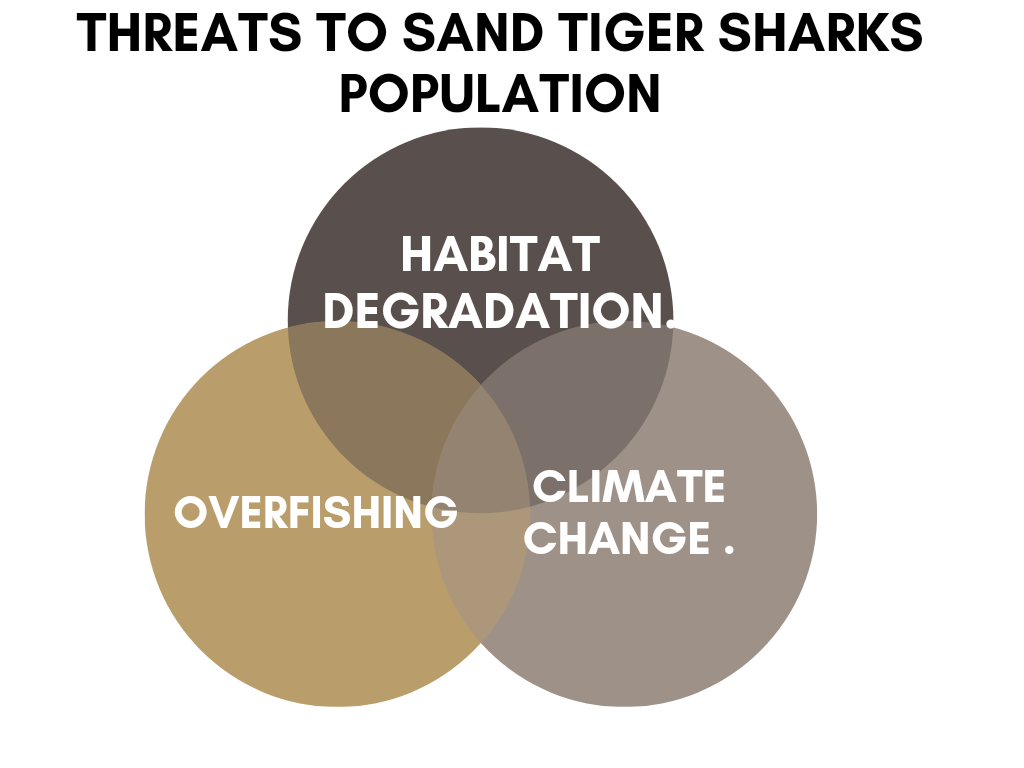
Key Takeaways
- Sand tiger sharks are currently listed as a vulnerable species, meaning they are at risk of becoming endangered in the near future.
- Despite their intimidating appearance, sand tiger sharks are generally not a threat to humans and are known to be relatively docile.
- Overfishing and habitat destruction are the primary factors contributing to the decline in sand tiger shark populations.
- Conservation efforts, such as implementing fishing regulations and creating marine protected areas, are crucial in ensuring the survival of sand tiger sharks.
- Sand tiger sharks play a vital role in maintaining the balance of marine ecosystems, and their decline could have negative consequences for other species and the overall health of the ocean.
Sand Tiger Sharks, aka Carcharias taurus, have always been a source of amazement to researchers and ocean-lovers alike. These majestic creatures, with their sleek bodies and daunting rows of teeth, are an iconic representation of oceanic biodiversity. But, are Sand Tiger Sharks endangered?
No, they aren’t classified as endangered yet. Despite their intimidating looks, they’re vulnerable to human activities like overfishing and habitat destruction. This puts the sharks in a precarious situation!
A strange fact about Sand Tiger Sharks is their reproductive method – they’re ovoviviparous, meaning they give birth to live young after a gestation period of nine months. This method produces fewer offspring than egg-laying species.
To assist in protecting these vulnerable sharks and other species, it’s essential for individuals and communities to back conservation efforts and promote sustainable fishing practices. Through this joint effort, we can guarantee the survival of these incredible creatures for future generations.
Background information about Sand Tiger Sharks
Sand Tiger Sharks, also known as Grey Nurse Sharks, are large, powerful predators found in temperate and tropical waters worldwide. With long, slender bodies and sharp-toothed mouths, these sharks are known for gulping air from the surface and storing it in their stomachs for buoyancy.
They’re not aggressive towards humans and rarely pose a threat. In fact, they prefer to avoid confrontation, feeding on smaller fish and crustaceans using their strong jaws.
An interesting aspect of Sand Tiger Sharks is their reproductive behavior. Unlike other sharks which lay eggs or give birth to live young, female Sand Tiger Sharks carry developing embryos until they’re ready to be born. This is called ovoviviparity.
Despite their intimidating appearance, many people fear Sand Tiger Sharks due to misconceptions. However, they play an important role in marine ecosystems, keeping prey populations balanced and preventing disruption.
Current population status of Sand Tiger Sharks

To understand the current population status of Sand Tiger Sharks, delve into the threats they face. Explore the sub-section ‘Threats to Sand Tiger Sharks’ to gain insights into the challenges these majestic creatures encounter in their survival.
Threats to Sand Tiger Sharks
Sand Tiger Sharks face many threats to their population status, including overfishing, habitat degradation, and climate change. Let’s explore these risks further.
Threats to Sand Tiger Sharks:
- Overfishing – Sand Tiger Sharks are often caught as bycatch. This reduces their numbers and disrupts marine ecosystems.
- Habitat Degradation – Human activities like coastal development and pollution damage their habitats. This limits their ability to reproduce and find prey, leading to population decline.
- Climate Change – Changes in temperature and acidity hinder proper development and physiological functions.
Additionally, female Sand Tiger Sharks have a unique reproductive strategy called “embryonic cannibalism.” During pregnancy, several embryos develop, but only one fetus per uterus survives. This adaptation ensures the strongest offspring has enough nutrition for growth.
In the early 1900s, large-scale shark culling programs were implemented in Australia due to concerns about human safety. Unfortunately, this caused a severe decline in Sand Tiger Sharks. Now, efforts are being made to restore their numbers and protect them. Conservation efforts for Sand Tiger Sharks are essential – we can’t have Jaws 5 – Revenge of the Extinct!
Conservation efforts for Sand Tiger Sharks

To ensure the conservation of sand tiger sharks, explore success stories in protecting these magnificent creatures. Learn about the remarkable efforts and achievements made in safeguarding their population.
Success stories in protecting Sand Tiger Sharks
Conservation efforts for Sand Tiger Sharks have led to some incredible success stories. Marine protected areas provide safe habitats and reduce human activities that can harm them. Collaborative research has helped us understand their behaviors, migration patterns, and breeding habits. Sustainable fishing practices, such as using hooks that minimize the chances of accidentally killing them, have also reduced mortality rates. Public awareness campaigns have educated people about conserving them. Diving tourism has given local communities a financial incentive to protect them. International cooperation through agreements and conventions has enabled cross-border conservation measures.
Importantly, Sand Tiger Sharks are not aggressive towards humans unless provoked. This further emphasizes the importance of preserving them – they contribute to healthy marine ecosystems.
The success story from Cape Hatteras National Seashore in North Carolina is truly inspiring. Strict regulations on beach fishing and increased public awareness have resulted in a rebound of the local population. This has given researchers and conservationists global hope that proactive measures can make a real difference.
Future challenges and prospects for Sand Tiger Shark conservation? It’s a difficult task, but we’re up for it – like convincing a shark to eat tofu instead of a juicy seal!
Future challenges and prospects for Sand Tiger Shark conservation
The Sand Tiger Shark is threatened by many issues, such as coastal development, pollution, and climate change. These disrupt their breeding and feeding grounds, and fishing practices targetting this species worsen the problem. To combat this, researchers are implementing sustainable fishing methods and regulations to protect juvenile sharks. Marine protected areas are also important.
Raising awareness of the shark’s importance in the oceanic ecosystem is key. Educating people about how their preservation helps other marine life forms can increase support for conservation efforts. Researching alternatives to shark fishing can also help.
Responsible tourism practices are a great way to make an impact. Eco-friendly tours that prioritize the well-being of these sharks can contribute to their protection, and show off their beauty to visitors.
Frequently Asked Questions
Q: Are Sand Tiger Sharks endangered?
A: Yes, Sand Tiger Sharks are considered vulnerable and are listed as a species of concern globally.
Q: What factors contribute to the endangerment of Sand Tiger Sharks?
A: Sand Tiger Sharks face numerous threats, including habitat destruction, overfishing, and incidental capture in fishing gear. These factors have led to a decline in their population.
Q: How many Sand Tiger Sharks are left in the wild?
A: The exact population of Sand Tiger Sharks is unknown, but their numbers have significantly decreased over the years. Estimates suggest that there are currently thousands, rather than millions, left in the wild.
Q: Why are Sand Tiger Sharks important to marine ecosystems?
A: Sand Tiger Sharks play a crucial role in maintaining the balance of marine ecosystems. As apex predators, they help regulate the population of their prey, indirectly influencing the entire food chain.
Q: What measures are being taken to protect Sand Tiger Sharks from further decline?
A: Conservation organizations and governments are implementing various measures such as establishing protected areas, banning shark finning, and promoting sustainable fishing practices to protect Sand Tiger Sharks and their habitats.
Q: How can individuals contribute to the conservation of Sand Tiger Sharks?
A: Individuals can support organizations working towards shark conservation, spread awareness about the importance of protecting these animals, and make sustainable seafood choices to reduce the overall demand for shark products.
Conclusion
The sand tiger shark – also known as Carcharias taurus – has been surrounded by controversy regarding its conservation status. It is not classified as endangered, but we must still consider potential threats.
Humans have caused population declines due to overfishing and habitat destruction. These sharks are vulnerable due to slow growth and low reproductive capacity. They often become bycatch in commercial operations.
To ensure their long-term survival, there are steps we can take. Implementing fishing regulations and quotas can reduce the accidental catch and prevent overfishing. Also, marine protected areas (MPAs) could provide safe havens for feeding and reproduction.
Raising public awareness is also important. Educate communities about the importance of sand tiger sharks – their ecological role, and their value in maintaining healthy marine ecosystems. This could be done through educational campaigns, outreach programs, and collaborations with local communities.
References
https://www.nationalgeographic.com/animals/fish/facts/sand-tiger-shark




